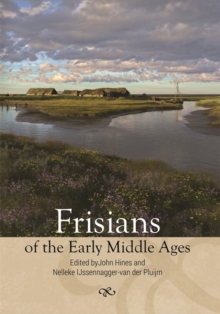
The Baiuvarii and Thuringi : An Ethnographic Perspective Hardback
Edited by Janine Fries-Knoblach, Heiko Steuer
Part of the Studies in Historical Archaeoethnology series
Hardback
Description
A study of two Germanic tribes, the Baiuvarii and Thuringi, looking at their origins, development, and customs between the fifth and the eighth centuries. The large neighbouring tribes of the Baiuvarii and Thuringi, who lived between the Alps and the River Elbe from the fifth to eighth centuries, are the focus of this book.
Using a variety of different sources drawn from the fieldsof archaeology, history, linguistics and religion, the contributions discuss how an ethnos, a gens, or a tribe, such as the Baiuvarii or Thuringi, might appear in the written and archaeological evidence.
For the Thuringi tribal traditions started around the year 400 or even earlier, while the Baiuvarii experienced a much later ethnogenesis from both immigrants and a local, partly Romance population in the mid-sixth century. The Baiuvarii and Thuringi are studied together because of the astonishing connections between their two settlement landscapes.
In the context of the row-grave civilisation the Thuringi belonged primarily to the eastern, the Baiuvarii to thewestern sphere.
The kingdom of the Thuringi was assimilated into the Merovingian Empire after their defeat by the Franks in the 530s, which also changed their burial customs to the style of the western row-grave zone.
In contrast,the Baiuvarii were not "Frankicised" until more than a century later and their grave customs remained more typically "Bavarian".
The chapters highlight typical features of each region and beyond: settlements, agricultural economy, law, religion, language, names, craftsmanship, grave goods, mobility and communication. Janine Fries-Knoblach is a freelance archaeologist with a special interest in the fields of settlements, agriculture and technology of protohistoric Central Europe, and has taught at a number of German universities; Heiko Steuer is Professor Emeritus of Prehistoric and Protohistoric Archaeology and Archaeology of the Middle Ages at Freiburg University, Germany, with a special interest in the social and economic history of Germanic tribes in Central Europe; John Hines is Professor of Archaeology at Cardiff University and is supervising the publication of the remaining volumes inthis series. Contributors: Giorgio Ausenda, Janine Fries-Knoblach, Heike Grahn-Hoek, Dennis H.
Green, Wolfgang Haubrichs, Joachim Henning, Max Martin, Peter Neumeister, Heiko Steuer, Claudia Theune-Vogt, Ian Wood.
Information
-
Available to Order - This title is available to order, with delivery expected within 2 weeks
- Format:Hardback
- Pages:396 pages, 63 b/w, 33 line illus.
- Publisher:Boydell & Brewer Ltd
- Publication Date:19/06/2014
- Category:
- ISBN:9781843839156
Information
-
Available to Order - This title is available to order, with delivery expected within 2 weeks
- Format:Hardback
- Pages:396 pages, 63 b/w, 33 line illus.
- Publisher:Boydell & Brewer Ltd
- Publication Date:19/06/2014
- Category:
- ISBN:9781843839156










